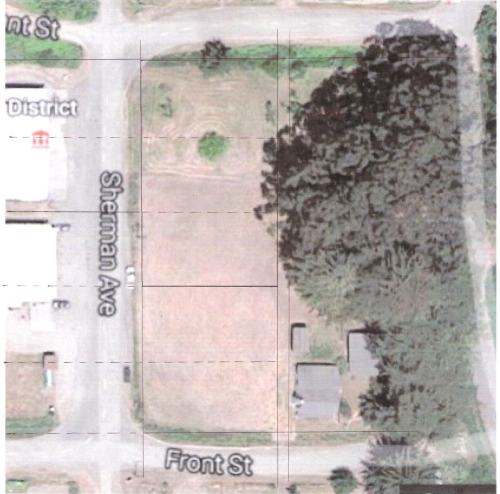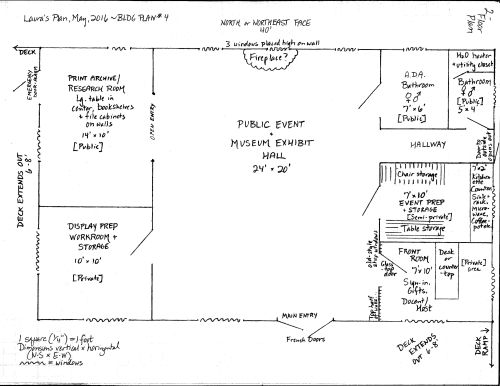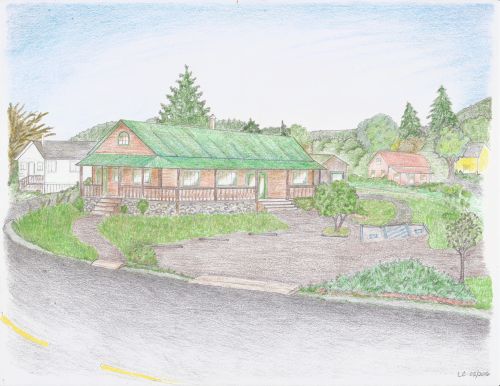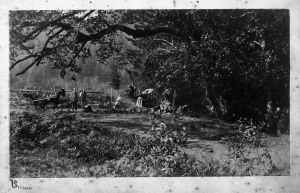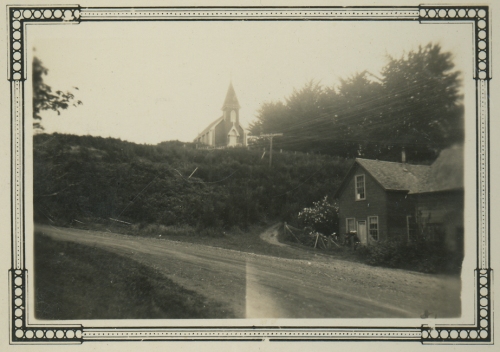A couple of years ago, the Mattole Valley Historical Society received this letter:

I mentioned the intriguing find in one of our Now… and Then newsletters, but I don’t think I had shared any of the photos publicly. Now that we have gotten good information to augment the pictures from a Rudolph descendant, Carolyn “Corky” Peterson of Fresno, it’s high time we showed off some of the pictures.
The Rudolph family itself merits a stand-alone post, but that’s something for another day. Briefly, the story is that three of the Rudolph siblings, children of Mary Hamblin and John Caspar Rudolph–born in the late 1700s in Austria–made their way to the Mattole Valley in the 1860s. The three were brothers John C., Morgan, and Thomas. John had the Petrolia Store, of which you have probably seen pictures; Morgan was a preacher throughout the Mattole Valley; and Thomas made his way to Upper Mattole before Honeydew was named. He homesteaded land, in 1889, at the foot of Woods Creek in Sections 2 and 11 of T3S, R1W, which was later owned by James Ballard, then later by Hunter (presumably Ballard’s brother-in-law, Judge G.W. Hunter)–in case you want to locate where, possibly, this family lived.
The Mattole Valley Historical Society has enjoyed the attention and membership of many descendants of these original three Rudolphs. Many of the Clarks, Hunters, Rackliffs (including Mary Rackliff Etter), and Wrights of recent history or current residence are descended from Morgan Rudolph, via his daughter Martha, who married Marshall Wright. Conrad Rudolph, a professor of medieval art history at UC Riverside, is a direct descendant of John Rudolph. And most valuable to identification of this photo collection, Corky Peterson is the granddaughter of Gwyneth Rudolph, who was herself the granddaughter of Thomas and Martha Coy Rudolph via William Rudolph and his wife, Caroline Langdon (a sister of Mrs. Charles Johnston and Mrs. Isaac Dougherty). So you can see that although the Rudolphs all departed the Mattole Valley by the first decade of the 1900s, they left their marks as prominent and influential citizens. In fact, Emma Rudolph, a daughter of Morgan and Rebecca Rudolph, kept a diary as a 15-year-old girl living in downtown Petrolia. The 1882 document would be another fascinating read on this blog, so stay tuned!
According to Corky, the photo albums are of the Thomas>William H. and Caroline>Gwyneth line–her grandmother’s family. Although many of the pictures (and most that I will post here) are, I believe, from the Mattole Valley, the family spread far, geographically; two of William’s sisters, Corky’s great-great aunts, married two Langlois brothers. The Langloises, for whom the town in Oregon just north of Port Orford is named, settled in the area from Coos Bay to Bandon to Port Orford–the Cape Blanco lighthouse (further west even than Cape Mendocino’s) being the residence of keeper James Langlois, along with wife Elizabeth Rudolph and at least five children, for 42 years. But Gwyneth herself retired to Marin County; she lived there with her daughter Norma, who was Corky’s aunt. That’s probably how the albums came to be found in Greenbrae, California.
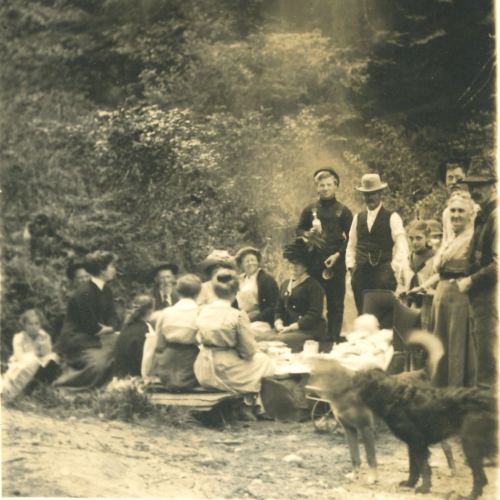
Corky and I think this picnic may be a Johnston family affair, the man about 4th from left resembling other photos of Charles A. Johnston; Mr. Johnston was married to Corky’s great-grandmother Caroline Langdon Rudolph’s sister Evaline.

Looks like a gulch of the lower Mattole Valley. (Maybe she is considering a hike up that little canyon, and a change of clothing.)

Possibly sisters Eveline and Caroline, ca. 1890, according to Corky. However, comparing with the photo of three sisters down this page a little, I think it might be daughters of Caroline: Nettie (older, left) and Alda (full name Martha Alda, younger)… photo perhaps taken by their middle sister, Gwyneth. Hand-held camera snapshot suggests the twentieth century.
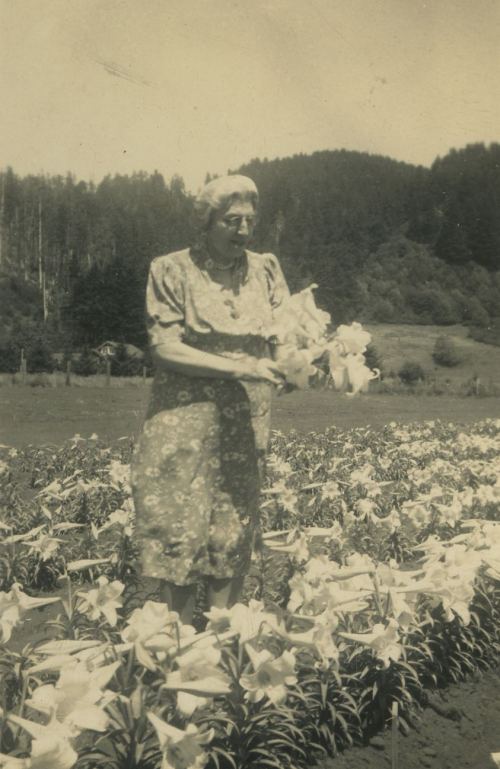
This is more recent, given the length of the lady’s dress. Tending the lilies.

Possibly the Joel Flat (sometimes called Henderson) oil well, which has also been captioned, in a Mary Rackliff Etter photo, the McIntosh well. If it is indeed that one, it would make sense to be seeing the Mattole Valley behind, to the south of it, heading westward/right to the ocean.

Same well. Note the small figures of men in the lower right. Looks like a plume of–what, oil vapor or froth coming off it?

Photo taken at unknown location, possibly Humboldt County. The man (unidentified, probably a friend of Grandmother Gwyneth’s) is sitting over a metal sign advertising Disston Saws for the California Saw Works–San Francisco, Seattle, Portland. An online search (you can find the signs on eBay) tells me that the signs were manufactured from 1901-1905 by Meek and Beach Co. I suspect the gate might be on land logged by a company contracted to California Saw Works.

Corky’s father, John (Jr., called Jack) Tyler, son of Gwyneth Rudolph Tyler. He was born in 1906; photo probably from about 1912 (when little boys were not pushed to dress in a manly fashion).
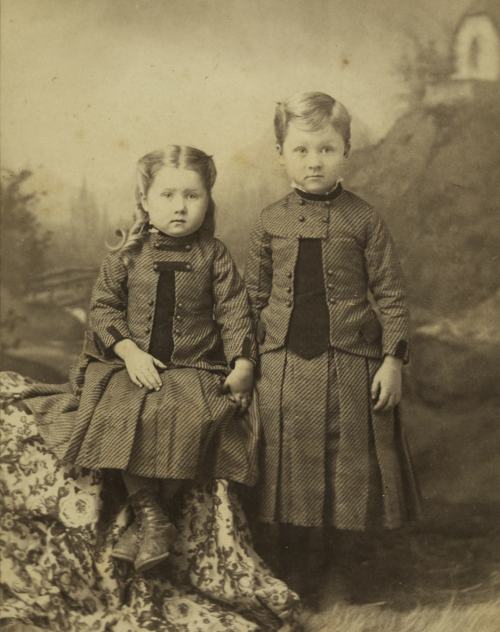
Gwyneth, mother of little Jack from the photo above, on the left; with her big sister Nettie, probably from around 1887 (when little girls needn’t have girly hairstyles).

About nine years later, the three daughters of William Rudolph and Caroline Langdon: Alda, Nettie, and Gwyneth.
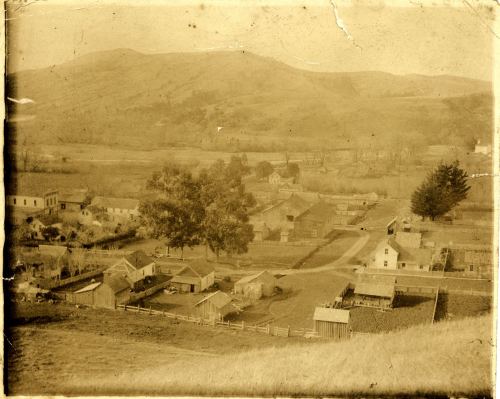
Petrolia from the hill to the east-northeast of the Square. Taken sometime before the 1903 fire. Several of the buildings still stand: you can see Ocean Berg’s (once Jim Groeling’s, a long time back the Watson-Cady house); Mary Day’s (once Lucy Wright and Elias Hunter’s); Swaffords’ (once Jack and Vivian Susan Wright’s, called Briarcrest); the Leonard Cook (Mayme Hunter’s) house on the southeast corner of the Square; and various sheds and barns that have survived. The old Knights of Pythias hall, site of the future MVHS museum, is on the Square, along with, to the south/left, the original hotel; the John Mackey store, and other buildings that burned down, are on Front St., along the far left. On the hill behind the North Fork valley, you can see a house, about a third of the way from the left of the photo. Is that one of the old Clark family places?
Below, a crop showing a tiny bit more detail:

~~~~~~~~~~~~~~~~~~~~~~~~~~
That’s all for now. We are very grateful to the Landgrafs of San Rafael, without whom we would never have seen these beautiful pictures… and to the internet, without which they may not have found us.
 The ragged cover of one of the albums.
The ragged cover of one of the albums.
